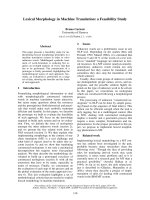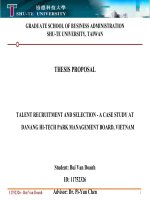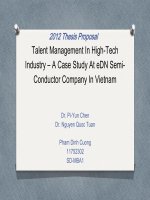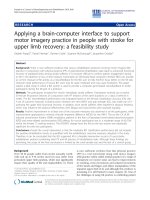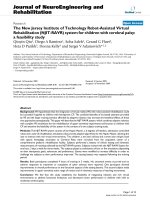Establishing a model custom hiring center: A feasibility study at Kandi Mandal
Bạn đang xem bản rút gọn của tài liệu. Xem và tải ngay bản đầy đủ của tài liệu tại đây (217.06 KB, 9 trang )
Int.J.Curr.Microbiol.App.Sci (2020) 9(5): 1299-1307
International Journal of Current Microbiology and Applied Sciences
ISSN: 2319-7706 Volume 9 Number 5 (2020)
Journal homepage:
Original Research Article
/>
Establishing a Model Custom Hiring Center: A Feasibility Study
at Kandi Mandal
B. Nagaraj*, Ch. Srilatha, S. Vikram, M. Venkatesh and Ch. Prameela
College of Agricultural Engineering, Sangareddy, Telangana-502001, India
*Corresponding author
ABSTRACT
Keywords
Machinery
economic feasibility
cropping pattern
soil type
Article Info
Accepted:
10 April 2020
Available Online:
10 May 2020
The present study was conducted in Kandi Mandal of Sangareddy district in Telangana state with objective
of analyzing the cost of establishing a model custom hiring center in the study area with required
machinery and its economic feasibility. The secondary data regarding the land holdings were collected
from the Mandal Agricultural Office, Kandi and District Agricultural Office, Sangareddy. Secondary data
about machinery and their prices were collected from Telangana State Agro Industries Development
Corporation Limited (TSAIDCL), Hyderabad. Tabular analysis and discounted project evaluation
techniques were used to worked out the establishment costs and returns and economic feasibility of the
model CHC respectively. Based on the parameters like cropping pattern, soil type and land holdings the
suitable type of implements and machinery were selected. The costs of the selected machinery and
implements with and without subsidy were calculated and also the gross expenditure and gross income
based on 100, 75 and 50 percent utilization of the services from the model CHC were also calculated.
From the analysis it was found that the total cost of establishing a model CHC along with shed stood at Rs
70.4 and 37.45 lakhs without and with subsidy respectively. The gross income realized from the model
CHC were Rs. 34.81, 26.11 and 17.41 lakhs and Rs.25.10,18.83 and 12.55 lakhs and the net income
realized from the model CHC were Rs 13.81, 10.36, 6.90 lakhs and 7.37, 5.53 and 3.69 lakhs without and
with subsidy at100,75 and 50 percent utilization of services of machinery and implements respectively.
The Net Present worth (NPW) was found positive and the Benefit Cost Ratio was more than unity at both
10 and 12 percent discount rates. The Internal Rate of Returns was found to be 14.76 percent and 14.83
percent without and with subsidy respectively which was higher than the bank rate of interest (7%) on long
term loans.
Introduction
Indian agriculture is undergoing a gradual
shift from dependence on human power and
draft animal power (DAP) to mechanical
power. Mechanization of agricultural field
operations is the need of hour in the present
Indian Agriculture. Mechanization of
agriculture in India has some constraints and
limitations like high initial cost which often
prohibits individual ownership especially
amongst small, marginal and medium farm
holders in addition to it, lack of knowledge in
the aspects of operation, maintenance and
repair of equipment often restricts the use of
farm machinery and lack of space for shelter
also constraints the use of machinery. To
overcome the above problems and to achieve
mechanization in the Indian farms custom
hiring centers (CHC) play a pivotal role in
1299
Int.J.Curr.Microbiol.App.Sci (2020) 9(5): 1299-1307
introducing high technology agricultural
machinery even to small farmers with the
objective to boost crop production, improve
quality, timeliness and efficiency of
agriculture operations. Mechanization of
agriculture will help in increasing the
productivity and reduce the cost of cultivation
and also enable the farmer to complete
farming operations in time.
The Custom Hiring Centers (CHCs) offer
farm equipment’s and machineries on rental
basis to farmers who cannot afford to
purchase high-end agricultural machineries
and equipment’s. Custom Hiring Centers
(CHS) an important mechanism through
which most small holders can access services
of agricultural machinery.
The present study is an attempt to analyze the
possibilities and prospects of increasing the
farm income of small and medium farmers of
the study area by establishing a model custom
hiring center and also to evaluate the
economic feasibility of the model CHC.
Materials and Methods
Kandi Mandal under Sangareddy District of
Telangana state was chosen for the study.
This area was chosen for the study as the
farmers in this area are growing major crops
like Paddy, Maize and Cotton where there is a
scope for mechanization. Simple random
sampling technique was adopted to select the
ultimate sampling units of major crop
growing farmers. Survey method was
employed to collect the data from the farmers.
The study is based on primary data as well as
secondary data. The primary data pertaining
to the production aspects of major crops were
collected directly from the farmers with the
help of a specially designed schedule by
personal interview and presented at current
prices (2018-19) to estimate costs and returns.
The secondary data regarding the land
holdings were collected from the Mandal
Agricultural Office, Kandi and from the
District Agricultural Office, Sangareddy and
data about machinery and their prices were
collected from Telangana State Agro
Industries Development Corporation Limited
(TSAIDCL), Hyderabad.
The computational procedure of cost of
operation per hour of machinery is calculated
by considering the two cost components of
machinery i.e. fixed and variable costs. The
variable costs such as labor, repairs, spare
parts, fuel, lubrication and maintenance costs
etc., increase proportionally with the
operational use, while the fixed cost remains
independent of the use of the respective
machine or the implement. The annual fixed
costs covered depreciation, interest on the
investment and the insurance.
Fixed costs
Depreciation
Depreciation is the decrease in the value of a
machine due to usage and time obsolescence.
The decrease in value is on the account of the
wearing out of the parts or on the reduced
capacity of the machine with use.
Straight-line method is used to calculate
depreciation considering the present and
salvage value (10 % of P) of the farm
machines and implements.
Depreciation =
, Rs/h
Where,
D = Depreciation, Rs
P = Purchase price, Rs
S = salvage Value, Rs
L = Economic machine life, years
H = Working hours per year
1300
Int.J.Curr.Microbiol.App.Sci (2020) 9(5): 1299-1307
Interest
Labour
Interest is used as a fixed cost estimate, as the
money which has been once used to buy a
machine cannot be used for any other
productive purpose. In case of farm
respondents, the cost of capital investment
was accounted at 10 percent rate of interest.
The labour contributed by men, women and
children of the farm operator or hired labour.
The labour wages were allotted according to
the work of operation of labour.
I
=
Where,
I = Interest rate, Rs
i = % rate of the interest
H = working hours per year, h
The data collected were subjected to
conventional tabular analysis to work out
costs and returns of model CHC. Discounted
cash flow techniques were used to analyze the
capital productivity of CHC. The following
discounted cash flow measures were used in
the analysis viz., Net Present Worth, BenefitCost Ratio and Internal Rate of Returns.
Net present worth (NPW):
Taxes, insurance and housing
These three costs are usually much smaller
than depreciation and interest, but they need
to be considered. An estimated charge of 1.0
% of the purchase price is suggested for taxes,
insurance and housing costs.
It is sometimes referred to as net present
value. It is the present worth of the
incremental net benefits or incremental cash
flow stream. The selection criterion of the
project depends on the positive value of the
net present worth when discounted at the
opportunity cost of the capital.
Operating or variable cost
Fuel cost
Net present worth =
Fuel costs can be estimated by calculating the
number of liters of fuel consumed in a year.
In actual practice the fuel consumption is
taken as 6 liters per hour for self-propelled
machines.
Where,
Bj = benefits in jth year
Cj = costs in jth year
i = discount rate
n = number of years
Lubrication cost
Benefit-cost ratio (BCR)
Surveys indicate that total lubrication costs on
most farms, on an average about 15 % of fuel
costs. Therefore, once the fuel cost per hour
has been estimated, you can multiply it by
0.15 to estimate total lubrication costs.
This ratio compares the present worth of costs
with present worth of benefits. The common
procedure of selecting the project is to choose
the projects having the B.C. ratio of more
than one, discounted at opportunity cost of
capital.
Repairs and maintenance
Repairs and maintenance cost can be taken
10% of initial operating cost per year
Benefit cost ratio
1301
=
Int.J.Curr.Microbiol.App.Sci (2020) 9(5): 1299-1307
Where,
Bj = benefits in jth year
Cj = costs in jth year
i = discount rate
n = number of years
Results and Discussion
Category of land holdings in the study area
Internal rate of returns (IRR)
It represents the average earning capacity of
an investment over the economic life period
of the project. It is that discount rate which
just makes the net present worth of the cash
flow equal to zero. In other words, the benefit
cost ratio calculated at IRR is unity.
IRR is the maximum interest that a project
could pay for the resources used if the project
is to recover its investment and operating
costs still break even. The IRR is arrived
through interpolation technique by using
different discount rates so as to see that the
net present worth is equal to zero. Therefore,
the project costs and benefits are discounted
at a certain rate to find out the present worth
of the project. Again, by selecting higher
discount rate, the costs and returns are
discounted throughout the project period to
get a negative net present worth. The higher
value of IRR indicates the first, while lowest
value being the last choice of preference.
However, the IRR should be more than the
discount rate being considered for economic
feasibility and financial soundness. If the
calculated IRR is greater than the market rate
of interest, then the investment is considered
viable.
IRR
=
Where,
ra = lower discount rate
rb = higher discount rate
NPVa = NPV using the lower discount rate
NPVb = NPV using the higher discount rate
The category of the land holdings in the study
area are shown in the Table 1. The results
showed that marginal and small farmers
constituted about 91.8 percent, medium
farmers accounted for 7.79 percent and large
farmers constituted about 0.42 percent of the
total land holdings in the study area.
Cropping pattern in the study area
The cropping pattern indicates the extent of
area grown under each crop as a percentage of
the total cropped area and is determined by
the resource availability of the farm. It is
evident from the Table 2 that, the principle
crops grown in the study area (Kandi) are
Maize, Cotton and Paddy which occupied
4242(32.28
%),
3686(28.05%)
and
1977(15.04%) acres respectively. Other
principle crops grown in the study area are
Jowar, Red gram, Soya bean etc.
Cost of establishment of a model CHC
Establishment of a CHC is a capital-intensive
technology requiring a substantial investment
especially during the initial establishment
period. The model CHC to be established in
the study area constitutes 19nosof machinery
and implements considering the cropping
pattern in the study area. Most of the farmers
depends on expensive informal hiring
systems, however timely availability is not
assured and expressed their willingness to
have a CHC. The total investment made on
the different farm machinery and implements
for establishing the model CHC is presented
in Table 3. The total cost of establishing a
model CHC along with shed is worked out as
Rs 70.4 and 37.45 Lakhs without and with
subsidy respectively.
1302
Int.J.Curr.Microbiol.App.Sci (2020) 9(5): 1299-1307
Custom hiring charges
Annual expenditure of model CHC
The charges of custom hiring services of farm
machinery were decided by calculating the
The estimated annual expenditure under
cost of operation of each selected machinery
model CHC without subsidy as against with
and implement per hour by taking their fixed
subsidy (50%) to the farmers of study area
costs and variable costs. The custom hiring
providing custom hiring services of farm
out charges per hour of farm machines and
machinery and implements were given in
implements and average working hours per
Table 5& Table 6.
year of the model CHC are presented in Table
4.
Table.1 Category of land holdings in the study area
Sl. No.
1
2
3
4
Category of farmers
Marginal
Small
Medium
Large
TOTAL
No of farmers
8738
1183
842
45
10808
Percentage (%)
80.85
10.95
7.79
0.42
100
Table.3 Cost of establishment of CHC with selected machinery without subsidy
and with subsidy
Sl.no.
Machinery and implements
Quantity
(no)
Unit cost
Rs in lakhs)
1
2
3
4
5
6
7
8
9
10
Tractor
Rotavator
Tractor Trolley
Laser Guided Land Leveler
Reversible 2 MB Plough
Cultivator (9 tine / 11 tine)
Disc Plough
Cage wheels
Seed cum Fertilizer Drill
Pneumatic Cotton Seed Planter
1
1
1
1
1
2
1
2
1
1
7.5
1
1.75
4
1
0.3
0.4
0.15
0.6
1
7.5
1
1.75
4
1
0.6
0.4
0.3
0.6
1
3.75
0.5
0.875
2
0.5
0.3
0.2
0.15
0.3
0.5
11
12
13
14
15
16
17
18
19
20
Paddy transplanter(6or8 row)
Automatic seedling machine
Power Weeder
Power sprayer
Cotton picker
combine harvester
Maize Sheller
Straw Baler
Shredder
Shed for implements 1000 sq. ft
1
1
1
2
5
1
1
1
1
14
2
0.8
0.02
0.2
25
0.16
3
1.75
14
2
0.8
0.04
1
25
0.16
3
1.75
4.5
7
1
0.4
0.02
0.5
12.5
0.08
1.5
0.875
4.5
TOTAL
70.4
37.45
1303
Total cost
0%
50 %
Int.J.Curr.Microbiol.App.Sci (2020) 9(5): 1299-1307
Table.4 Custom hiring out charges per hour of the selected farm machinery and
implements in CHC (Rs)
Sl.no.
Name of the Machinery
Cost of operation per hour
0 % Subsidy
865
50 % Subsidy
762
Working
hours /year
1
Tractor
1000
2
Rotavator
93
47
300
3
Tractor Trolley
140
70
300
4
Laser Guided Land Leveler
185
93
550
5
Reversible 2 MB Plough
93
47
300
6
Cultivator (9 tine / 11 tine)
19
10
400
7
Disc Plough
34
17
300
8
Cage wheels
28
14
300
9
Seed cum Fertilizer Drill
67
34
250
10
Pneumatic Cotton Seed Planter
111
56
250
11
Paddy Trans planter (6 or 8 row)
2388
1474
250
12
Automatic seedling machine
315
158
200
13
Power Weeder
529
493
300
14
Power sprayer
255
254
250
15
Cotton picker
70
11
250
16
Combine harvester
2258
1459
500
17
Maize Sheller
10
6
400
18
Straw Baler
951
805
300
19
Shredder
121
61
400
Table.5 Gross expenditure, Gross income and net income per annum of model CHC
without subsidy (in Rs. lakhs)
Sl no
1
2
3
Particulars
Gross Expenditure
Gross Income
Net income
100%
21.0
34.81
13.81
1304
Utilization
75%
15.75
26.11
10.36
50%
10.50
17.41
6.9
Int.J.Curr.Microbiol.App.Sci (2020) 9(5): 1299-1307
Table.6 Gross expenditure, Gross income and net income per annum of model with
subsidy (in Rs.lakhs)
Sl no
Particulars
Utilization
100%
75%
50%
1
Gross Expenditure
17.73
13.30
8.86
2
Gross Income
25.10
18.83
12.55
3
Net income
7.37
5.53
3.69
Table.7 Estimation of NPW, BCR and IRR at various discount rates with 0% subsidy
Sl no
Particulars
1
Net present worth (Rs.)
2
Benefit Cost Ratio
3
IRR
Discount rates
10%
12%
15%
1172046.19
624999
-52748.4
1.0654
1.0372
0.9965
14.76%
Table.8 Estimation of NPW, BCR and IRR at various discount rates with 50% subsidy
Sl no
Particulars
Discount rates
10%
12%
15%
1
Net present worth (Rs.)
632972
341135.45
-20454.056
2
Benefit Cost Ratio
1.0482
1.027
0.998
3
IRR
14.83%
Economic viability of model custom hiring
centre
The costs and returns are not the perfect
measure to assess the profitability from
investment made on CHC. Before making a
choice on any enterprise, it becomes
necessary to examine the economic feasibility
of that enterprise. The length of the period a
particular enterprise bears fruits play a key
role in the selection of indicators that would
examine the economic feasibility of the
enterprise. Several techniques are available
for evaluating economic viability of CHC.
The cash inflows and outflows were
discounted at 10, 12 and 15 per cent to
estimate NPW, BCR and IRR with subsidy
(50 %) and without subsidy.
It was observed from Tables 7 and 8 that the
Net Present Worth was high and ranged from
Rs 11, 72,046.19 at 10 percent to Rs 52,748.4
at 15 percent discount rates without subsidy
and ranged from Rs 6,32,972 at 10 percent to
1305
Int.J.Curr.Microbiol.App.Sci (2020) 9(5): 1299-1307
Rs.20,454.056 at 15 percent discount rates
with subsidy (50 %). The positive net Present
Worth found between 10 and 12 percent
discount rates indicated the soundness of the
investment made in CHC. The Benefit Cost
Ratios worked out were 1.0654, 1.0372, and
0.9965 without subsidy and 1.0482, 1.027,
and 0.998 with subsidy (50 %) at 10, 12 and
15 percent discount rates respectively. The
Internal Rate of Returns was found to be more
than the bank discount rate of (7%) on long
term loans and worked out as 14.76 percent
and 14.83 percent without and with subsidy
respectively. Hence the CHC enterprise is
economically feasible.
The present study revealed that marginal and
small farmers constitute about 90 percent of
the land holdings. Hence, establishment of
custom hiring centres at Mandal provides an
opportunity to the marginal and small-scale
farmers to avail the services of the expensive
machines on custom hiring basis. The major
crops like maize, paddy and cotton occupied
75% of the cropped area which are the major
sources of income to the farmers and these
crops are labour intensive too. Hence,
establishment of CHC in the study area
overcomes labour scarcity and nonavailability of machinery.
The total cost of establishing a model CHC in
the study area stood at Rs 70.4 and 37.45
lakhs without and with subsidy. Subsidy
scheme formulated by government will
encourage young entrepreneurs and Agriengineering graduates to set up a CHC with
low cost. The scope of establishing model
CHC was encouraging as revealed through
the net income generated by the model CHC
with 100, 75 and 50 percent utilization of
services of machinery and implements. The
investment on model CHC was economically
feasible as the NPW was positive at 10 and 12
percent interest rates and the BCR was more
than one at the above interest rates.
The IRR was found to be more than bank rate
of interest (7%) under both cases of with and
without subsidy.
References
Beaton A J, Dhuyvetter K C, and Kastens T L
(2003) Custom rates and the total cost
to own and operate farm machinery in
Kansas.
Available
at
http://
www.ksre.ksu.edu.
Parashunath, Hiremath G M and Prashanth.J
(2016) constraints of farmers in
utilizing custom hiring service (CHS) of
tractor based farm machineries- An
Analysis International Journal of
Agricultural
Science
and
Research.6(1):217-220.
Sharma V K, Singh K and Panesar B S (2005)
customhiring of agricultural machinery
and its future scope. Status Report on
Farm Mechanization in India. pp 127132. Department of Agriculture and
Cooperation, Ministry of Agriculture,
Government of India, New Delhi.
Sidhu R S and Vatta K (2012) Improving
economic viability of farming: A study
of cooperative agro machinery service
centres in Punjab. Agril Econ Res
Rev25: 427434.
Srivastva N S L (1999) Role of agricultural
engineering in doubling food production
in next ten years. Agril Engg Today23
(1-2): 37-49.
Thakur T C, Khura T K, Kishor R and
Amdekar S J (2004) Economics of
custom hiring of combine harvesters in
north-western indo-gangetic plains of
India- a case study. J Agril Engg 41
(4):16-24.
Vaja K.G, Dobariya U.D and Yadav Rajuir.
(2016) Exploration of custom hiring
services of farm machines in Junagadh
International Journal of Agriculture
Sciences. 8(47), 1946-1948.
1306
Int.J.Curr.Microbiol.App.Sci (2020) 9(5): 1299-1307
How to cite this article:
Nagaraj. B, Ch. Srilatha, S. Vikram, M. Venkatesh and Ch. Prameela. 2020. Establishing a
Model Custom Hiring Center: A Feasibility Study at Kandi Mandal.
Int.J.Curr.Microbiol.App.Sci. 9(05): 1299-1307. doi: />
1307

